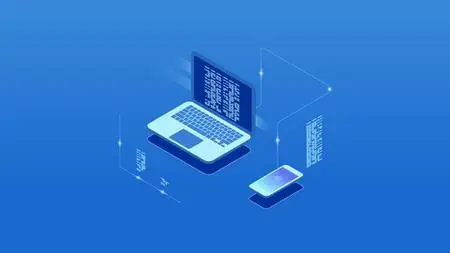Survey Of Python For Gis Applications
Last updated 12/2020
MP4 | Video: h264, 1280x720 | Audio: AAC, 44.1 KHz
Language: English | Size: 6.71 GB | Duration: 13h 24m
Last updated 12/2020
MP4 | Video: h264, 1280x720 | Audio: AAC, 44.1 KHz
Language: English | Size: 6.71 GB | Duration: 13h 24m
Introduction to the python language and ecosystem for GIS professionals
What you'll learn
This course is broad rather than deep. My goal is that when finished, students have some knowledge of the tools in the python ecosystem for geospatial applications and more importantly, how they all work together. More detailed courses will be forthcoming. Some of the topics covered will be
An introduction to the language and its core principles.
An introduction to object oriented programming in python.
FInding and using third party python modules.
Working with the operating system
Working with files
Working with databases
Reading spatial data with GDAL/OGR
Visualizing data with matplotlib and other tools
Data Analysis with pandas and geopandas
Jupyter notebooks
Requirements
This course is not a beginner programming course. I assume you have some programming knowledge, i.e. what . variable is, what an expression is, what a loop is, what a function is, etc. But i do go over the basics of how all those things are implemented in python.
Description
This course covers the basics of the python language, the python language, and the core python packages for data analysis, especially of geospatial data. The goal of the course is to provide a broad introduction to the capabilities of python and how all the various packages work together. This will provide a starting point for deeper exploration on your own or in future courses.Introduction to pythonObject oriented pythonPackages and modulesUnit testsJupyter notebooksNumpyMatplotlibPandasFiona and shapelyGeopandasRasterioGeocodingPyQt
Overview
Section 1: Introduction
Lecture 1 Introduction
Lecture 2 What is python?
Lecture 3 Why use python?
Lecture 4 What can you do with Python?
Lecture 5 What can you do with python? - Part 2 GIS
Lecture 6 About Python
Section 2: Installing Python
Lecture 7 Getting started
Lecture 8 Installing Python on MacOS
Lecture 9 Installing PyCharm on MacOS
Section 3: Getting started with Python
Lecture 10 Boolean and numeric variables
Lecture 11 Converting between variable types
Lecture 12 Strings
Lecture 13 String methods
Lecture 14 String formatting
Section 4: Operators and expressions in Python
Lecture 15 Operators Part 1
Lecture 16 Operators Part 2
Lecture 17 Expressions
Section 5: Complex data structures
Lecture 18 Lists
Lecture 19 Working with lists
Lecture 20 Tuples
Lecture 21 Sets
Lecture 22 Working with sets
Lecture 23 Dictionaries
Lecture 24 Working with dictionaries
Lecture 25 Review of complex data structures
Section 6: Program control
Lecture 26 The if statement in Python
Lecture 27 While loops in Python
Lecture 28 For loops in Python
Lecture 29 Generators
Section 7: User Input
Lecture 30 The input() function
Lecture 31 Command line arguments
Lecture 32 Working with user input
Section 8: Functions
Lecture 33 Introduction to functions
Lecture 34 Function example
Lecture 35 Function arguments
Lecture 36 Map and filter functions
Lecture 37 Lambda functions
Lecture 38 Nested functions, decorator functions, and scope
Section 9: Error Handling in Python
Lecture 39 Error Handling in Python
Lecture 40 Error handling - Part 2
Section 10: Modules
Lecture 41 What is a module?
Section 11: Objects in python
Lecture 42 What is an object?
Lecture 43 Defining a custom object class
Lecture 44 Object example
Lecture 45 String representation of an object
Lecture 46 Object inheritance
Lecture 47 Private properties and methods
Lecture 48 Principles of object oriented programing
Section 12: Python packages, virtual environments, and documentation
Lecture 49 What is a package?
Lecture 50 Working with third party packages
Lecture 51 Virtual Environments
Lecture 52 Virtual Environments - Part 2
Lecture 53 Documentation in python
Section 13: Formal testing in python
Lecture 54 The unittest module
Lecture 55 Writing a test suite for the Point class
Section 14: Working with the operating system and files
Lecture 56 The OS module
Lecture 57 The OS.path submodule
Lecture 58 Reading and writing plain text files
Lecture 59 Reading and writing plain text files - Part 2
Lecture 60 Creating a word count application
Lecture 61 Reading and writing CSV files
Lecture 62 Reading and writing CSV files - Part 2
Lecture 63 Word Count Application - Part 2
Lecture 64 Working with JSON data
Lecture 65 Working with JSON data - Part 2
Lecture 66 Word Count Application - Part 3
Lecture 67 Working with shape files
Lecture 68 Working with shapefiles - Part 2
Lecture 69 Application: Shapefile to GeoJSON converter
Section 15: Working with database data
Lecture 70 Working with database data
Lecture 71 SQLite example
Lecture 72 PostgreSQL and PostGIS
Section 16: The python data science stack
Lecture 73 Introduction
Lecture 74 Jupyter Notebooks
Lecture 75 Numpy
Lecture 76 Matplotlib
Lecture 77 Pandas
Section 17: Geospatial analysis in python
Lecture 78 GDAL/OGR
Lecture 79 Fiona and Shapely
Lecture 80 Geopandas - Part 1
Lecture 81 Geopandas - Part 2
Lecture 82 Rasterio
Lecture 83 GeoPy
Lecture 84 Where to go next
Section 18: Bonus Lectures
Lecture 85 Bonus Lecture: How to get the most from my series of Udemy courses.
This course is oriented towards geospatial professionals who want a better understanding of the complete python ecosystem for geospatial applications.,For this course I will not go into detail about any specific python tool, rather this is intended to be an introduction to the language and an overview of its capabilities.



